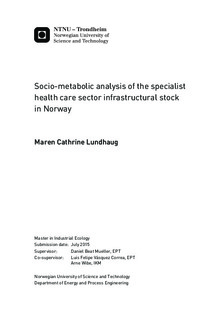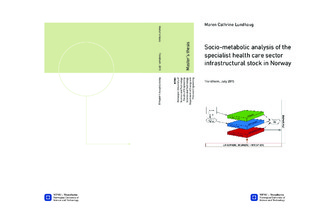| dc.description.abstract | Abstract
We often do not mentally connect the provision of services like healthcare and education to the emissions of greenhouse gasses. Because we often do not regard the service of healthcare as a physical product, disregarding the materials involved. In addition, there is a knowledge gap of understanding how demographics and the populations demand for services affects the throughput of materials and energy in the social metabolism, which further relates to greenhouse gas emissions.
The service economy we currently have in Norway calls for new methods for understanding how we affect and interact with our environment.
In an attempt to assess part of this gap, we have built two models for the service of treating and investigating colorectal cancer in Norway. A sector that is expected to account for 174,2 billion NOK in 2015 and are under an enormous pressure of delivering a high level of service to the population, with a low cost and within a limited timeframe.
To do this we have looked at the overall treatment capacity in Norway for 2013 and built scenarios for 2040, in an attempt to understand how the aging of the population will affect the demand for treatment. Our second model looks at waiting times for colorectal cancer treatment, due to data availability this is built as a conceptual model exemplifying how we can model waiting times. Both models are only conducted for the patient flow, due to data availability.
Essential in both is the understanding of where the emissions occur; we therefor have three layers in our model (1) the patient layer, (2) the employment layer and (3) the infrastructure. And it is in the third layer in which we interact with our environment.
Although we have not gotten as far as assessing the two other layers we have used this as a basis for how to move forward with this research. However, our results for the patient layer clearly shows that there is a need for long-term management in the healthcare sector. In addition, that by 2040, as the age distribution differs from 2013, we will need more healthcare personnel and more infrastructure if we aim to provide the same level of service as we currently do. | |

